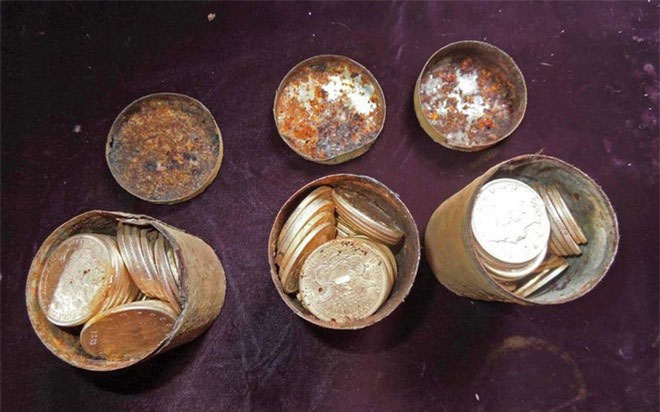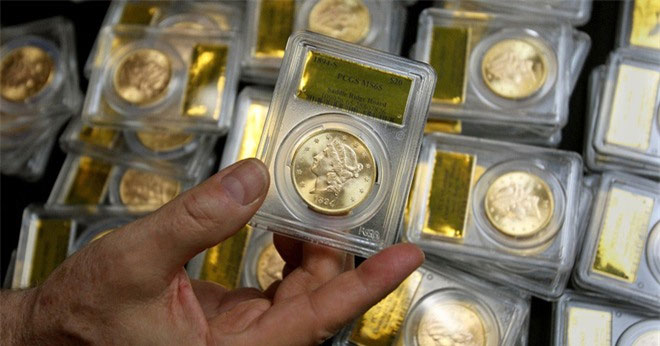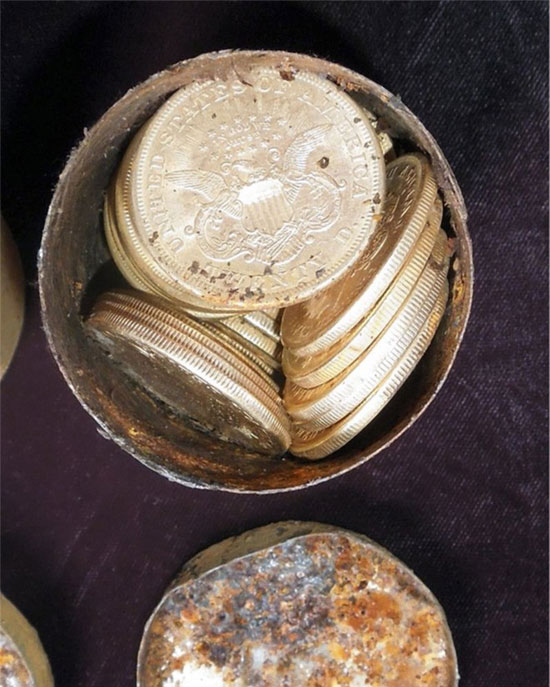Eight years ago, a rare treasure from the California Gold Rush was discovered by an American couple. According to the valuation by the currency trading company Kagin in California, the treasure is worth over 10 million USD (more than 200 billion VND).
While walking their dog, the couple accidentally spotted a rusty metal can protruding from the ground. They pulled it up and found many gold coins inside, and then they continued to dig further and discovered seven more cans.

Gold coins found in the rusty metal can.
David McCarthy, a coin expert from Kagin, stated that the treasure consists of over 1,400 gold coins dated from 1847 to 1894. When discovered, these gold coins were still in pristine condition inside the metal cans. Experts have named the treasure the Saddle Ridge Hoard.
These coins were not buried all in one place but were scattered throughout the area where the couple found the treasure. This suggests that the owner of the treasure buried them on multiple occasions. Currently, experts have yet to determine who hid this gold, so the treasure has been recognized as the couple’s property.
Mr. David also added: “We have collected thousands of gold coins from shipwrecks in the past, but we have never seen a treasure of such a large quantity buried underground like this. This is also the first time we have seen this type of coin with a denomination of 20 USD in North America.“

Most of the gold coins are sold on Amazon, with the remainder displayed at the American Numismatic Association. (Photo: NBC News)
The couple brought the coins to Kagin for appraisal. After thorough examination, David’s company classified and counted the gold coins. Specifically, this treasure includes nearly 1,400 gold coins with a denomination of 20 USD, 50 gold coins with a denomination of 10 USD, and 4 coins with a denomination of 5 USD. Among them is a special coin, the 1866-S No Motto Double Eagle, which has been valued at up to 1 million USD.
Kagin stated that they would sell most of the gold coins on Amazon on behalf of the couple. Additionally, they will transfer a portion of the treasure to the American Numismatic Association for display. However, Kagin declined to disclose the couple’s identity at their request due to concerns that treasure hunters might come to steal their property.
The California Gold Rush began in January 1848 after James W. Marshall discovered gold at Sutter’s Mill in Coloma, California. Following this, many people from Oregon, the Sandwich Islands (Hawaii), and Latin America flocked to California. More and more people came to California from all over the United States and the world. By 1855, at least 300,000 people had arrived here to try their luck.
The Gold Rush quickly became known worldwide as the “California Dream.” According to historian H. W. Brands, in the years following the Gold Rush, the California Dream spread nationwide.

The treasure found filled with gold coins from the California Gold Rush era. (Photo: NBC News)
In literary history, the Gold Rush is reflected in works by Mark Twain such as The Celebrated Jumping Frog of Calaveras County, Bret Harte with A Millionaire of Rough-and-Ready, and Joaquin Miller with Life Amongst the Modocs, among others.
Among the modern legacies of the California Gold Rush is the state motto of California, “Eureka” (“I have found it”), images of the Gold Rush on the state seal, and the state’s nickname “The Golden State,” as well as the names of several locations here.


















































